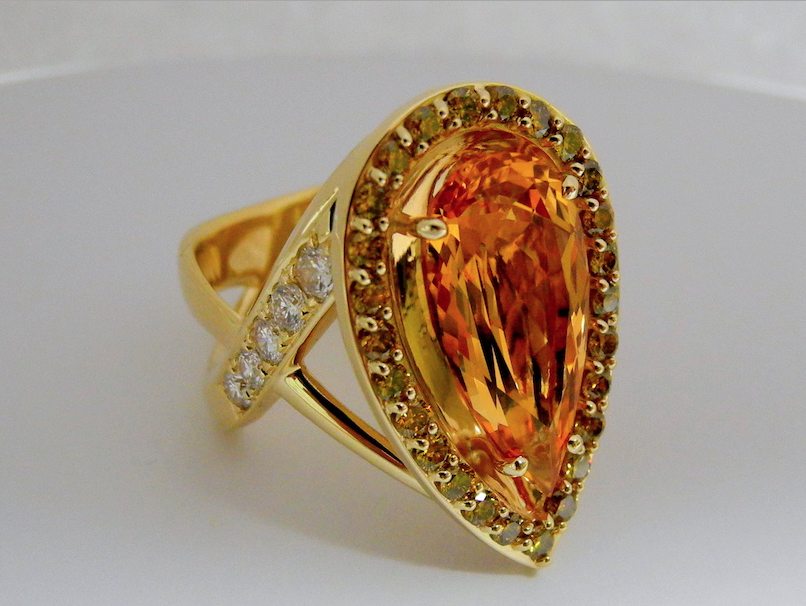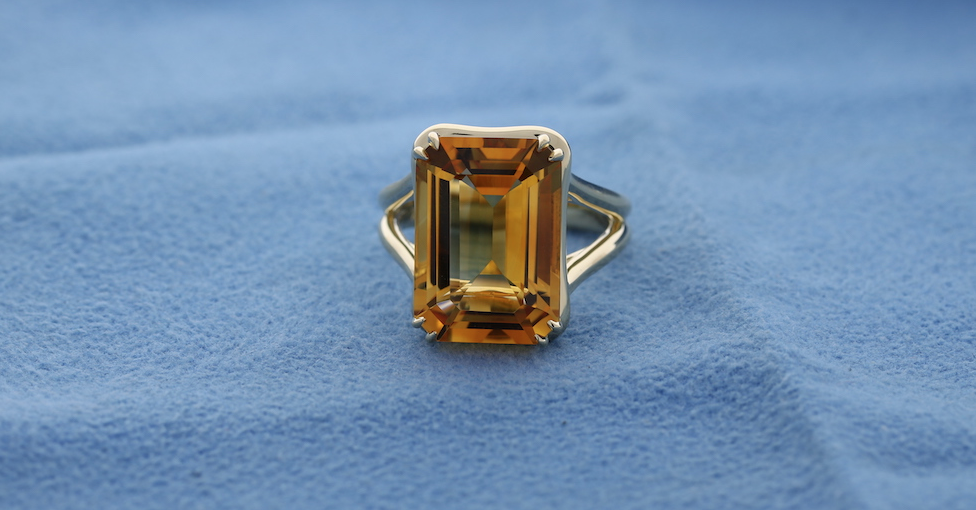November Birthstones
If you were born in November, you are part of the two-birthstone club that includes people born in March, August, and October. Your birthstones — Topaz and Citrine — offer a number of colors that fit nicely with autumn, including yellow, orange, violet, and brown.
Here’s what you need to know about November’s two birthstones, starting with Topaz:
History of Topaz
This November gemstone’s name is believed to come from the Sanskrit word tapas, which means “fire.” Another possible root of the name is the Greek topazios, which was the ancient name given to Zabargad Island (aka St. John’s Island) in Egypt’s Foul Bay, although topaz was never actually found there.
In 1768, the royal court in Portugal celebrated the discovery Imperial topaz, which has a pinkish-orange color. There is some debate as to whether Portugal is where the “imperial” moniker originated, or if that qualifier came from Russian royalty in the 1880s. It was at that time that the royal family insisted on reserving the best colors of the gem for themselves, which is when topaz was mined from Russia’s Ural Mountains. However, topaz goes back much further than that — all the way back to ancient Greece.
Brazil is currently the largest producer of high-quality topaz and features many colors. Pink topaz is found in Pakistan, but even in the area with the highest concentration of the gem, pink is a rare hue. Topaz can also be found in Namibia, Myanmar, Nigeria, Madagascar, Mexico, Sri Lanka, Russia, and even here in the United States, where Texas Blue Topaz is the official gem of the States of Texas, and traditional topaz is the official gem of the State of Utah
The most common hues of topaz are colorless, yellow, pink, light blue, orange, violet, brown and, occasionally, red. Most of the blue topaz seen today is not naturally occurring but created by treating colorless topaz with heat. The “Mystic Topaz” rainbow hue is created by putting a thin artificial film coating on colorless topaz. Topaz is allochromatic, which means that its color is not caused by chemical composition, but by impure elements or defects in its crystal structure.
Traditionally, blue topaz is the gem used when marking a fourth wedding anniversary, while Imperial topaz is the gem used for the 23rd wedding anniversary.
Lore of Topaz
The ancient Greeks believed topaz gave them strength, and in Europe during the 1300-1600s, people thought the stone could dispel anger and thwart magic spells. For many centuries, the people of India maintained that wearing topaz above the heart would ensure a long life, intelligence, and beauty.
Before the 20th century, all yellow/orange/brown transparent gems were referred to as topaz. Because of this, topaz was associated with a golden hue and was thought to attract gold and wealth to the wearer.
Cleaning and Care of Topaz
Topaz is an 8 on the Mohs scale and quite hard, but it has low toughness, so it must be cleaned very carefully. (As a reminder, the Mohs’ is a scale of hardness used in classifying minerals.) Do not use steam or ultrasonic cleaners on topaz, because high heat can cause internal breaks in the stone. Here at Shmukler Design, we recommend cleaning topaz with warm, soapy water to prevent cracking.
Topaz is generally stable when it comes to light, but the yellow-to-brown versions of the gem can fade with too much sunlight or prolonged exposure to heat. Topaz may also be affected slightly by some chemicals, so remove the gem when cleaning jewelry with chemicals, just to be safe.
Note: The coating on the Mystic Topaz — which is handmade — can withstand normal wear but needs gentle cleaning. Use a mild soap solution to clean your birthstone if it has been treated this way.
Next, let’s talk about Citrine:
History of Citrine
Citrine, which wasn’t originally identified as a birthstone for November, is a transparent yellow to brownish-orange variety of quartz that has been used in jewelry for thousands of years. At one point, it was actually confused with the other November birthstone, topaz. As its citrus hues would suggest, citrine is purported to be named after the French word for lemon, citron. The yellow-to-orange color actually comes from traces of iron, not lemon.
The ancient Greeks carved citrine into rock crystal ornaments, while Roman pontiffs wore rings with massive amethysts that are thought to have been citrine. Citrine was also very popular in Scottish jewelry in the Victorian era, and today is the traditional gift for a 13th wedding anniversary.
Note: Today, most of the citrine in the marketplace is the result of a heat treatment of amethyst, because natural citrine is so rare.
The top sources for this November birthstone are Spain, Bolivia, Mexico, Madagascar, and Uruguay. Amethyst that is heat treated to a citrine color is often mined in Brazil.
Citrine Legends
Due to its confusion with topaz, many once believed that citrine had the same purported soothing powers as November’s other birthstone. Today, citrine’s enthusiasts boast about its own “powers,” such as promoting creativity and personal clarity, as well as curbing self-destructive tendencies. Citrine is also said to be associated with the values of hope, youth, strength, health, cheerfulness and fidelity.
Finally, the people who lived in China during the 2nd millennium BCE until the end of the Han dynasty in 220 CE, called citrine the “stone of success,” with the emperors of that time attributing their ability to increase intellectual capabilities and broaden their minds to the wearing of the gem.
Taking Care of Citrine
Both November birthstones have good hardness, with citrine at a 7 on the Mohs scale, but citrine has better toughness features than topaz. Citrine is durable enough for normal wear and can be cleaned with warm, soapy water. If you want, you may use an ultrasonic cleaner for your citrine jewelry, but since steam cleaning could cause cracks, we recommend avoiding that method altogether.


